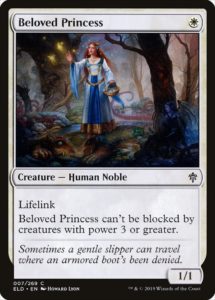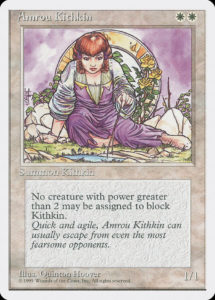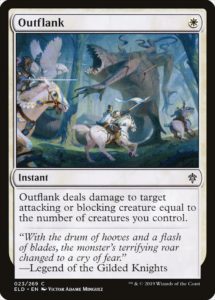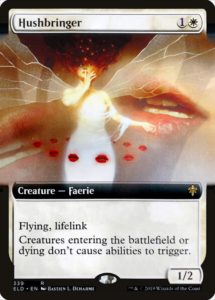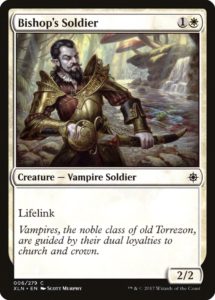There is plenty of digital ink to be spilled on format defining cards like Oko, Thief of Crowns, Veil of Summer, and Once Upon a Time. But every now and then, it’s worth giving some scrutiny to the Tar Snares of the world.
The majority of Magic cards aren’t major marquee memorabilia, but they serve vital purposes like filling out the world of a set, making Limited function, or being something for a sliver of the player base to fall in love with. Today, we’re here to talk about one such card.
A Noble Addition
Beloved Princess has quite a bit going on despite being a fairly simple Magic card. She is one of several cards to introduce the Noble creature type. For a long time, creatures in positions of leadership or aristocracy were often given a racial creature type and nothing else (Falkenrath Noble, Brago, King Eternal, Merfolk Sovereign). This is a small change, but it helps flesh out worlds ever so slightly more while allowing fewer creatures to conspicuously lack the class type that most sentient creatures seem to have. While I don’t expect Noble tribal to be supported more than Brushwagg tribal anytime soon, I’d bet that there’s already a Commander deck waiting for the day.
I Amrou Evasive
Beloved Princess hearkens back to Legends’ Amrou Kithin, the first creature with this kind of cautious evasion. This is a fairly rare ability—only four cards possess it: Beloved Princess, Daxos of Meletis, Kithkin Armor, and, of course, Amrou Kithin. Sure, there are creatures which are more cautious (Arctic Foxes, Fleet-Footed Monk, Sneaky Homunculus) and less so (Goldmeadow Dodger, Duskmantle Operative), and those with the Skulk mechanic; but this isn’t a common ability in contemporary Magic sets. We far more often see green’s ‘Daunt’ ability on cards like Garenbrig Paladin, where large green creatures get an alternate evasion mechanic from Trample.
The Amrou ability isn’t particularly strong, especially since it always appears on tiny creatures. It’d be exceptionally powerful on a 4/4, as there it’d function as Menace that always incurs a 2-for-1. On a 1/1, however, that makes it easy prey for Curious Pairs and Lost Legions. Still, it’s a cheap ability and it’s nice seeing Wizards pull this out of mothballs twice this year.
Not so Limited utility
Beloved Princess has been impressive in Limited. Sure, she’s only white’s third-best one drop (behind Faerie Guidemother, white’s arguably best common, and Gingerbrute), but white is all about a swarm strategy. White is rewarded for playing lots of cheap creatures with Outflank (an often superior removal spell to Trapped in a Tower) and Silverflame Ritual. Heck, with a quick trip to an Idyllic Grange and Weapon Rack, Beloved Princess becomes a serious-difficult-to block threat—and a 3/3 lifelink that needs to be double-blocked to kill is also quite difficult to race.
Beloved Princess is an unassuming card that can be the glue of powerful draft decks. Sure, she’s nowhere near as strong as Ardenvale Tactician or Silverflame Squire, but both of those cards get better when there’s a critical mass of cheap creatures. And unlike Gingerbrute or Faerie Guidemother, you can count on her wheeling.
Insert a Thousand Words
I love what Howard Lyon has done with the artwork. You can see a combination of innocence, curiosity, beauty, and surprising danger all in one composition. She showcases the contrast between the courts and the Wilds, and introduces both helpful and nefarious faeries, all while posing the question of which fairy tale she’s from and what will happen next. I love this piece and it makes me believe that through fortune, faerie assistance, or innocence she manages to avoid all those dangerous creatures with power 3 or greater.
Siphoning Vitality? Healing?
The only qualm I have with Beloved Princess is a frequent friction between designing for flavor and designing for function (which normally wins out). While Flying, Trample, and First Strike generally have some clear flavor, Lifelink is a bit more nebulous. Lifelink is often justified by creatures siphoning life, angels being angelic, or healers having martial magic (Ajani’s Sunstriker). While lifegain makes great sense in white, lifelink is harder to explain (especially since mechanically it plays like stealing life or gleefully enjoying damage dealing). There is the explanation of it being combat medicine (Rhox Faithmender is delivering healing medicine to the front lines?), but then there are non-magical cards like Charmed Stray or Beloved Princess that don’t seem to fit any of the explanations for what they’re doing to justify Lifelink.
Yes, it’s a nitpick, and yes, Magic is a better game for not having abilities locked to creatures that make 100% flavor sense; but this nitpick is the one ding on a stellar design (and even then, it’s a critique of the mechanic more so than the card). Beloved Princess is a much more interesting card to play with thanks to her having Lifelink (even if it muddles the story ever so slightly).
And that, in 800 words or so, is Beloved Princess. She’s not the most exciting card, but there’s a lot to see just beneath the surface of her and every other card. I encourage all of you aspiring designers or design fans to research some of the forebears of the next random common you come across—you’ll likely be pleasantly surprise to see how much, or how little, has come before.
And, as always, thanks for reading.
—Zachary Barash is a New York City-based game designer and the commissioner of Team Draft League. He designs for Kingdom Death: Monster, has a Game Design MFA from the NYU Game Center, and does freelance game design. When the stars align, he streams Magic (but the stars align way less often than he’d like).

